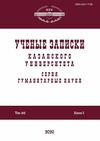Структура сравнительных предложений в языке турецких СМИ
Upon the Structure of Comparative Sentences in the Language of Turkish Mass Media
Author(s): K. A. VerkhovaSubject(s): Media studies, Syntax, Lexis, Semantics, Turkic languages
Published by: Казанский (Приволжский) федеральный университет
Keywords: Turkish language; Turkish mass media; functional-semantic field; functional-semantic field of comparison; complex sentence; polypredicative sentence; diachronic aspect;
Summary/Abstract: This article is devoted to the analysis of the structure of comparative sentences in Turkish mass media texts of the 20th and 21st centuries. The interest in this topic has been triggered by the question of whether the language of Turkish mass media can be recognized as a form of literary Turkish, as well as by the potential for establishing the structural patterns of Turkish polypredicative and complex sentences. The latter can be used for a comparative historical analysis of the syntax of Turkic languages, which still has not yet been attempted. Here, the research aims to trace the development of syntax in the language of Turkish mass media through the example of the functional-semantic field of comparison. In order to fulfill this aim, the following tasks were solved: to study the functional-semantic field of comparison as a language universal and to analyze its structure; to investigate the morphological, lexical, and lexical-syntactic means of expressing comparison in Turkish that are used in the structure of polypredicative and complex sentences; to examine in detail how these means are used in the texts of Turkish mass media; and to review the statistical data on the changes taking place in the structure of comparative sentences in the language of Turkish mass media. The obtained results show that the language of modern Turkish mass media is characterized by a gradual transition from morphological to lexical-syntactic means of expressing comparison, as well as by the optional use of lexical means and the loss of their syntactic independence. Furthermore, the dominance of means belonging to the microfield of qualitative comparison was revealed. The most preferred and frequently used constructions anchored in the language turned out to be the construction of assimilation -DIğI gibi in the microfield of qualitative comparison and the construction of degree with the additional meaning of potentiality -(y)AcAk kadar in the microfield of quantitative comparison.
Journal: Ученые записки Казанского университета. Серия Гуманитарные науки
- Issue Year: 164/2022
- Issue No: 5
- Page Range: 84-96
- Page Count: 13
- Language: Russian

